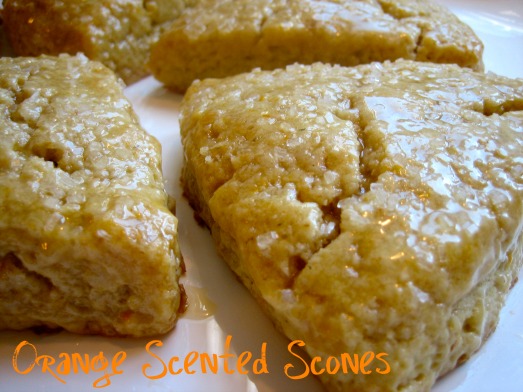
My second favorite way to relax and unwind (after baking, of course) is curling up in a cozy spot, wrapped in a fluffy blanket, sipping on a piping hot mug of French vanilla tea. When the kettle whistle blows, the tension in my body immediately begins to ease, as I eagerly await the curative brew with which I start and end each day. While I don’t have an ounce of British heritage, I swear I belong in the UK, where “tea breaks” are practically a national pastime. There is something magically restorative about enjoying a good cup of tea, and I highly recommend incorporating the soothing beverage in your repertoire, especially as an accompaniment to any indulgent sweet treat starring as your breakfast, snack, or dessert. There is no culinary couple that can quell an anytime craving quite like tea and scones- the ultimate European gastronomic duo. Like peanut butter and jelly or milk and cookies, tea and scones simply belong together, flawlessly complimenting each other’s best attributes. Both tea and scones have quite a bit of ground to cover to surpass coffee and muffins in regard here in the US, but thanks to recipes like this week’s SMS selection, tasters are being converted with just one bite.

A small quickbread (or cake if the recipe includes sugar) of possible Scottish origin, the scone is a popular treat in many countries around the world, but especially in the UK, Australia, New Zealand, Ireland, Canada and of course, the US. They are usually made of wheat, barley or oatmeal, with baking powder acting as the leavening agent. The name is said to derive from the Middle Dutch schoonbrood, schoon meaning “pure and clean” and brood meaning bread. The original scone was a round and flat cake (now commonly referred to as a bannock), that was usually the size of a small plate, made with unleavened oats, and baked on a griddle. It was then cut into triangle-like quadrants, or scones, for serving. The scone evolved into the oven-baked, well-leavened pastry we know today when baking powder was introduced to the market and became widely available to the masses. While the British scone is often lightly sweetened, it can also be savory, and popular mix-ins include raisins, currants, cheese or dates. In contrast, scones in the US are typically drier, larger and sweeter, and are standard coffee shop fare, featuring fillings such as cranberries, blueberries, nuts, or even chocolate chips.
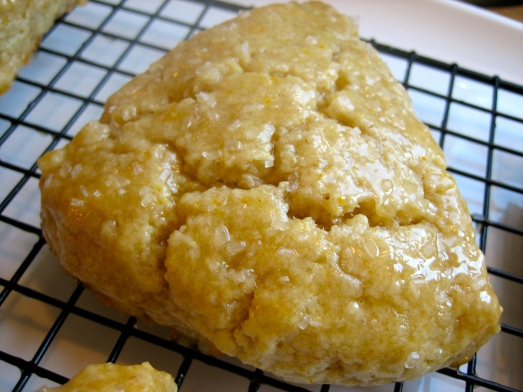
There are a few keys to producing an excellent scone, and ways to avoid the dreaded “hockey puck” consistency that gives scones a bad name. Both temperature of ingredients and mixing method are crucial components to consider. It is best if all the ingredients are cold, to add the liquid to the dry ingredients all at once, and then to mix everything together quickly and lightly. Because the butter is “cut-in” to the dry ingredients (just like in making pie dough), it is crucial that it’s cold, so it becomes small, flour-coated crumbs rather than melting and forming a smooth mass- this step is what ultimately gives scones their characteristic delicate, flakey texture. After the liquids are added, it is imperative to mix the ingredients as little as possible (only until everything comes together)- an overworked scone is usually hard and doughy, so a light hand is essential. When the dough is turned out and formed into a disc, it can either be cut into triangles, or rounds by using a cookie cutter. If you opt for the latter method, it is recommended to twist the cutter through the dough instead of pushing straight down, which yields higher rising scones during baking. Brushing the scones with an egg wash or some additional milk/cream imparts a gorgeous golden color and helps encourage browning. When they’re removed from the oven, you can either allow them to cool uncovered for a crusty exterior or wrap them (still hot) in a clean towel for a softer outer layer. Scones are best served warm and eaten the same day they’re made. Classic accompaniments include butter, jam or preserves, clotted cream, and/or lemon curd, however, a well-made scone is delicious even when plain. If you keep these tips in mind, scone baking is relatively easy, and you’re guaranteed to produce a winning treat.
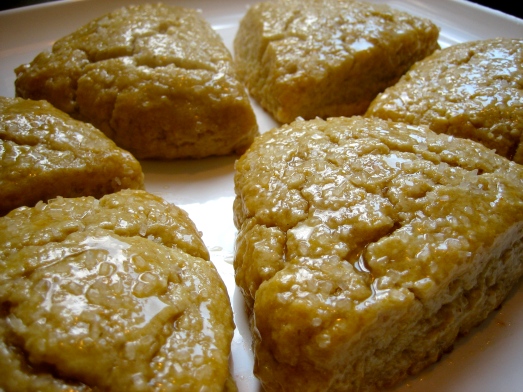
This is especially true when you have a sure-fire recipe to fall back on, like the Orange Scented Scones from The Sweet Melissa Baking Book. When I first read the recipe, chosen by Robin of Lady Craddock’s Bakery, it seemed like a very basic cream scone dressed up with a bit of grated orange zest. I wanted my scones to deliver a punch of orange flavor, so I pumped up the citrus volume in a few places. I added the zest of one whole orange (which was a bit more than the specified two teaspoons) and then turned to my pantry, which is stocked with a variety of flavored extracts, including orange. I mixed a teaspoon of orange extract into the wet ingredients for that extra hint of citrus essence all throughout the dough. But I didn’t stop there! I knew I wanted to accent my scones with some sort of glaze, and while my first thought was to go the confectioners sugar/orange juice route, I stopped short in my tracks when I discovered a honey butter scone glaze recipe featured in one of my favorite cookbooks, A Passion for Baking, by Marcy Goldman. In an “A-ha!-in-the-kitchen” moment, I thought, why not add a splash of that Grand Marnier (or orange liquor) I have leftover from the Fallen Chocolate Soufflé Cake? Perfect! With triple the orange zip, the scones were tangy, bright, and super refreshing. The sticky sweet glaze kept them ultra moist on days 2 and 3 (I can’t report on any longer since they didn’t last more than that!) I’m confident the classic scone recipe would be a great canvas for any flavor profile you’re craving, and by changing up the mix-ins with different fruits, spices, nuts, and zests, you never have to make the same scone twice! I highly recommend giving the glaze recipe a try as well (either spiked with your favorite liquor or booze free)- dry, chalky stones… I mean, scones, be gone!
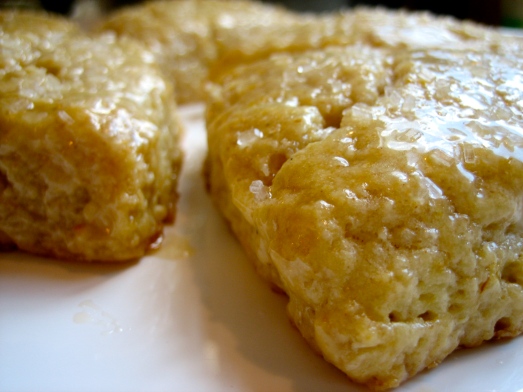
Thank you to Robin of Lady Craddock’s Bakery for this excellent tea-time pick! Head on over to her site for the recipe, and have fun playing with it and making it your own. Get some other great ideas by checking out all the delicious scones baked up by the other lovely ladies of SMS!
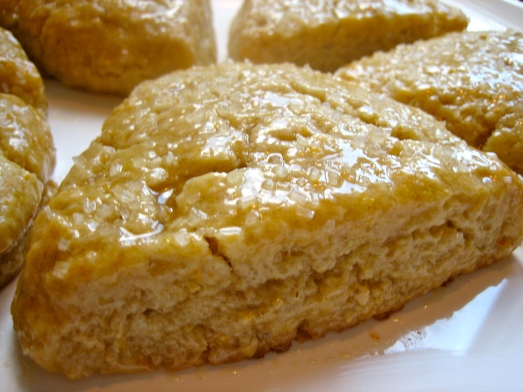
Just in case you’d like to test my version, here’s the fabulous (and truly simple) glaze recipe I used:
Scone Glaze
from A Passion For Baking by Marcy Goldman
Ingredients:
1/3 cup honey
¼ cup or 4 tablespoons unsalted butter
1 tablespoon flavored liquor such as Grand Marnier (optional)
1-2 tablespoons sparkling or sanding sugar to coat
Directions:
While the scones are baking, heat honey and butter in a liquid measuring cup in the microwave until mixture is just simmering, about 1 minute, stirring halfway through. Let cool slightly, and then stir in the liquor if using.
Brush the scones lightly with honey-butter glaze as they come out of the oven. Let stand on baking sheets. Repeat with more honey-butter glaze, more generously, about 15 minutes later. Sprinkle with the sanding sugar and let set.

